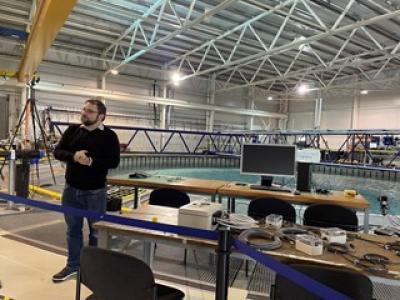The FloWave system can replicate a range of different wave patterns that exist at sea, and can also replicate them exactly again and again, allowing for thorough investigation of technologies being tested in its waters. As in the ocean, the tank can also produce currents so technologies are tested in conditions that most closely mimic the real world. The tank is equipped with a wide range of monitoring equipment, including accelerometers, gyrometers, optical motion capture cameras, wave and current sensors, as well as compression load cells - which convert force into electrical signals. This means that clients of FloWave can customize the features of the tank to fit their own models, and receive extremely accurate information about the viability and weaknesses of their technology under different conditions.
With the race on for Scotland to meet its goal of reaching Net Zero emissions by 2045, testing facilities for new renewable energy technology – like FloWave – are more important than ever. FloWave is unique in that it uses a circular tank, rather than the traditional rectangular shape, which allows it to simulate waves coming from all directions, and thus making it highly specialized for the testing of offshore renewable energy technologies. In fact, this tank is the first circular combined wave and current facility in the world. But this is not all that makes FloWave different.
“FloWave is a facility but also a team,” says Principal Experimental Officer, Thomas Davey. “A dedicated team of eight people that cover a mix of engineering, research, and technical aspects that look after the facility, make sure it operates correctly, but also run all the projects that come through here.”
“We're trying to enable research in its broadest sense - that's industrial research and academic research - and sometimes we can be very heavily involved in all aspects of it. We can be designing experiments, designing hardware, heavily involved in the analysis; sometimes it's a lighter touch depending on the group. Ultimately, we're trying to use our knowledge to make sure the facility operates to its highest level so that people get the highest quality results out of what we do.”
FloWave has worked with many local Scottish renewable industry actors over the years, including Wave Energy Scotland, Mocean Energy, and AWS Ocean Energy, as well with as companies as far away as Australia. But FloWave is constantly trying to bridge the gap between pure commercial and pure academic work being done at the facility to drive forward research on offshore renewables as a whole, realizing co-benefits for both, as well as for society.
“A lot of the work we do that really uses the full capability of the tank is academic research – the people who are really interested in the ability to generate very complex conditions with or without physical models in the tank. We can then take the learnings from that and bring it into the industrial world,” says Davey.
So what has changed at FloWave over the last 10 years? According to Davey, while the facility itself has not changed much since 2014, what has changed is the team’s understanding of its capability. As researchers have worked with the tank over the years, the knowledge embedded in the team has grown, allowing them to use the technology in novel aways. Additionally, technological advancements for measuring the outputs of models used in the facility have improved over time.
“The tank has always been very capable at generating complicated conditions, and it's even more capable now that we understand the machine better than ever. But it's only as good as what you put in and you only learn as much as you can measure,” says Davey.
But possibly the most important difference over the last decade is the growth of FloWave’s relationships with the research and industry communities who bring their models in for testing at the site. The symbioses of academic might, industry resources and know-how, and the technology of the FloWave facility, as well as the capability of the team behind it, has led to some truly impressive innovations over the years.
But while some things have changed at FloWave since 2014, what has not changed is the extremely high quality of service the facility and its team provide to its clients, as well as its undeniable contributions to progress on renewable energy development in Scotland.



